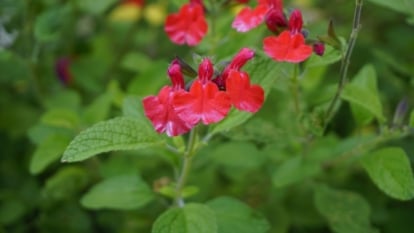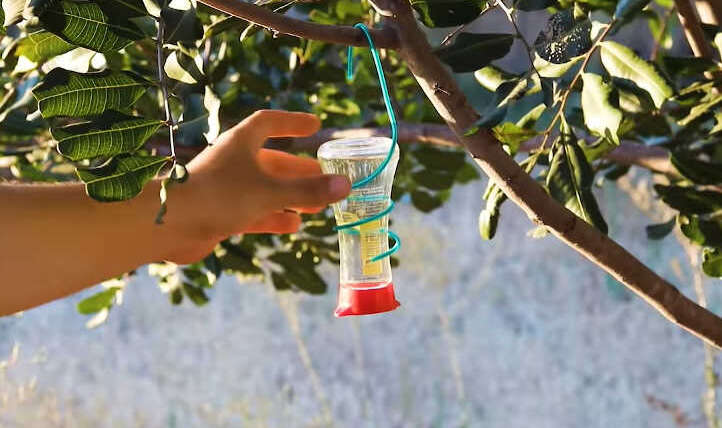Roses are hardy perennials. Tougher than their reputation suggests, these woody shrubs can adorn your garden with bouquet-worthy blooms and enticing perfume for decades. So, you’ve planted your roses, water them regularly, and all should be good! Right?
Well, maybe. Like all plants, roses are susceptible to problems that impact their health and good looks. A pest might munch the leaves. Rainy days might encourage mildew to set in, or maybe you just bought a diva that doesn’t suit your garden! A rose variety known for good health and disease resistance is always your best line of defense.
If you want to know what’s up with your roses, this list will describe the 15 most common problems you might face and what to do about them. Ready to get your roses back to beautiful? Let’s do it.
Diseases
Many rose diseases can be prevented by giving roses adequate sun and following the guidelines for water, pruning, and sanitation. But even the most experienced gardeners encounter diseases from time to time. Here are a few common rose diseases that plague roses, with tips on how to combat them:
Black Spot
Black spot is a common disease in roses characterized by circular black blotches on the foliage.
If you grow roses, you’ll see black spot. It’s inevitable, and no cause for panic. Though unsightly, this common disease spread by the fungus Diplocarpon rosae won’t kill your plant.
ID It: Black spot starts at the bottom and works its way up the plant. The foliage has circular black blotches, sometimes surrounded by a ring of yellow or brown. If severe, canes may be affected and develop rust-colored patches.
Why it Happens: Black spot loves the cool, wet conditions of early spring. The fungal spores travel in splashing water and infected plant matter, spreading to new roses when leaves stay moist for 7 hours or more.
Solve it:
- Water at the base of the rose (at root level) rather than overhead to keep foliage dry.
- Water in the morning so the day’s sunshine can dry up wet soil and leaves.
- Remove infected leaves when they appear (snap them off easily by pulling down with your fingers), and clean up thoroughly. If you leave them on the ground, they’ll reinfect the rose. The spores can overwinter to attack roses again next spring.
- Spray remaining foliage with a copper fungicide to slow future spread.
Powdery Mildew
 Powdery mildew thrives in humidity and wet foliage, resulting in a white fuzzy powder on rose bushes.
Powdery mildew thrives in humidity and wet foliage, resulting in a white fuzzy powder on rose bushes.
Tiny spores of the fungal pathogen Podosphaera pannosa cause powdery mildew in roses. Similar to black spot, it likes humidity and wet foliage.
ID: Rose bushes look like they’re coated in a white fuzzy powder. The plant may look withered, with curled-up leaves and buds that never open. It begins with circular white spots on the foliage and spreads to the rest of the plant.
Why it Happens: Powdery mildew flourishes when hot, dry days are followed by cool, damp nights. The spores spread via the wind or contact with infected plant matter.
Solve it:
- Plant roses in full sun (6-8 hours per day is ideal).
- Water at the base of the plant in the morning.
- Try spraying the fungus off with a sharp blast from the hose (don’t do this often because you want to keep foliage dry).
- If the spray doesn’t work, prune off infected foliage and dispose of it.
- Sterilize your pruners (rubbing alcohol works great) between plants and before touching healthy leaves.
- Spray the remaining foliage with a fungicide as an extra precaution. Home remedies like baking soda or milk sprays are also worth a try, but so far have little scientific backing.
Rose Rust
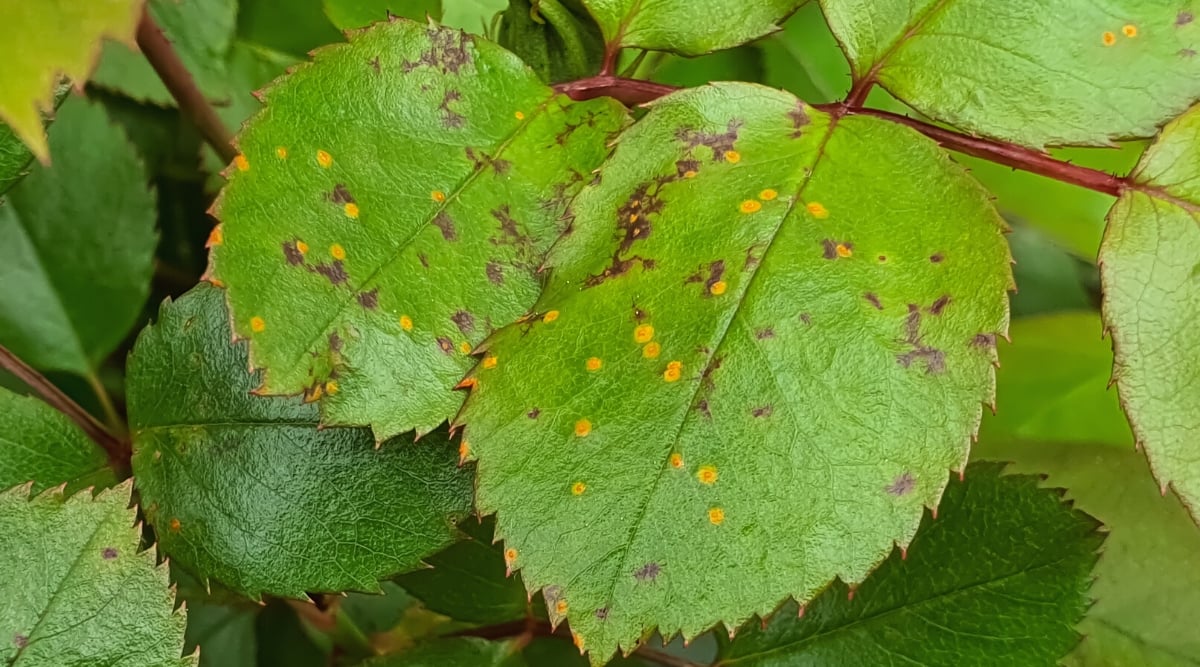 Rose rust thrives in wet, mild conditions, resulting in yellow spots on the tops of leaves and orange to black circular pustules.
Rose rust thrives in wet, mild conditions, resulting in yellow spots on the tops of leaves and orange to black circular pustules.
This common rose issue is another unattractive fungal infection. This time the culprit is the spores of Phragmidium fungus, which loves wet, mild conditions and needs two or more hours of moisture to develop.
ID: The tops of leaves get yellow spots, while the undersides have orange to black circular pustules that house the fungal spores. As it advances, leaves turn entirely yellow and drop from the plant. Canes may develop rusty lesions.
Why it Happens: Rust is common and spreads through the wind, splashing water, and contaminated tools. Overly wet conditions encourage its proliferation.
Solve it:
- If you catch it early, you can prune out infected matter and prevent the spread.
- An application of copper fungicide after pruning can reduce further spread.
- Roses planted in full sun and properly spaced (minimum 2-3 feet apart) are least likely to be affected.
- Sanitize tools and clean up debris right away.
- Water early and at the base of the rose.
- Rose rust is untreatable once the whole plant is impacted. Remove it and dispose of it away from the garden. Do not compost infected material.
Botrytis Blight
 This disease typically occurs in rainy weather and affects rose petals with soft, tan blotches.
This disease typically occurs in rainy weather and affects rose petals with soft, tan blotches.
Botrytis blight occurs most often during mild, rainy weather (around 60℉). It’s caused by the fungus Botrytis cinerea, which also affects other garden ornamentals.
ID It: Petals may have soft, tan blotches. Buds may turn brown, mushy, and never open. As they decompose, the buds develop a wooly gray coating. Canes with prior wounds provide a spot for the fungus to enter, leading to spreading cankers.
Why it Happens: Spores of the fungus can travel via insects (like aphids), wind, water, and unsanitized tools. Wet conditions encourage it to stick around.
Solve it:
- Botrytis blight resists most fungicides. Instead, prune off all impacted buds, blooms, and canes.
- Keep up the good practices that can prevent most fungal infections: clean up debris, sanitize tools, and water at the base of the plant early in the day.
- Prune to maintain good airflow (a vase-like shape with an open middle is best) and plant roses with 2-3 feet of space between them.
Stem Canker
 This problem occurs when various fungi colonize prior wounds from pruning, winter damage, insects, or friction.
This problem occurs when various fungi colonize prior wounds from pruning, winter damage, insects, or friction.
Stem canker results when prior wounds from pruning, winter damage, insects, or friction from rubbing canes are colonized by a fungal pathogen. The fungus varies, but some common causes are Botrytis cinerea, Leptosphaeria, and Cryptosporella.
ID It: Canes develop lesions that may be brown, black, yellow, or tan. The margins are brown or purplish. They slowly become larger, eventually girdling the cane. If allowed to spread to the crown, the whole plant will weaken.
Why it Happens: Roses that are already wounded are more susceptible to fungal infection because the wounds give the fungus a place to enter. The fungi themselves travel via the typical means of wind, water, and contact with infected debris or contaminated tools.
Solve it:
- Don’t let the pathogens spread. Trim down the infected canes 5 inches below the canker and dispose of them. Usually, no further treatment is necessary.
- Good sanitation is key! Use rubbing alcohol (put it in a jar and dip your pruners in, or use a spray bottle) to clean tools between plants or whenever they come into contact with disease.
- Monitor your roses for damage and be proactive about pruning it out. Prune canes that cross each other, causing friction wounds.
Downy Mildew
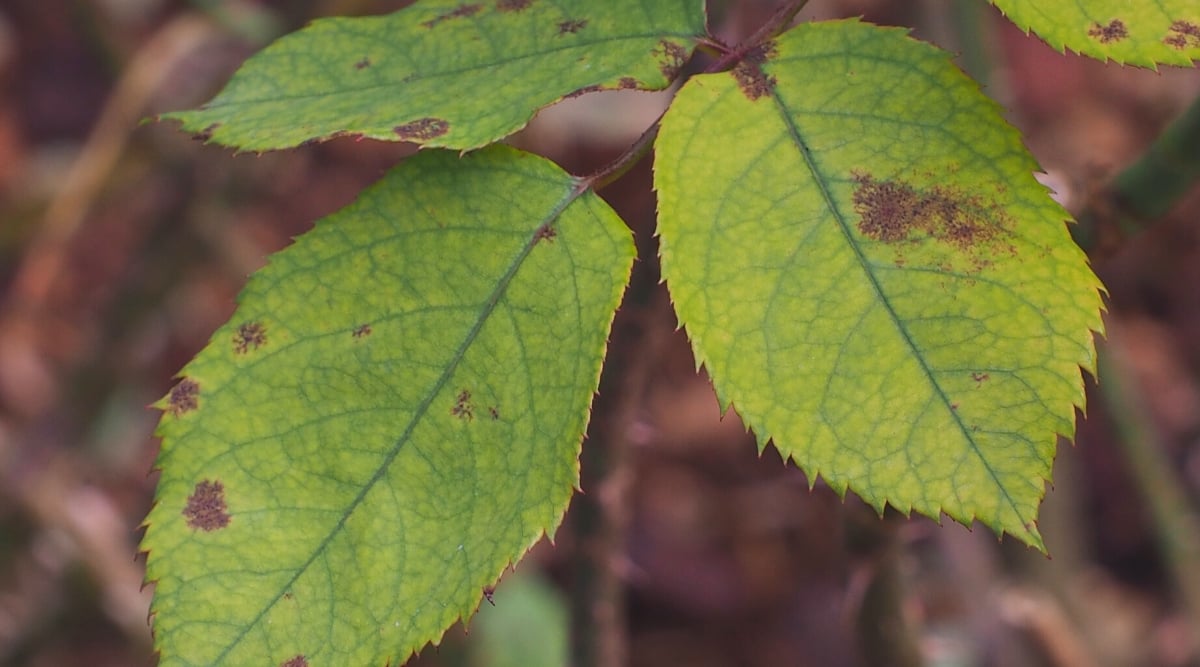 This disease is a common problem for rose-growers, caused by the pathogen Peronospora sparsa.
This disease is a common problem for rose-growers, caused by the pathogen Peronospora sparsa.
Downy mildew is frequently confused with black spot and, while it’s less common, is still a prevalent problem for rose growers. It’s caused in roses by the pathogen Peronospora sparsa and can also infect cane-berry bushes like blackberries and raspberries. Like most rose diseases, it prefers moist conditions and high humidity.
ID It: Splotches of brown, purple, or yellow discoloration are angular and run along the leaf veins. A fuzzy, grayish mass of spores may show up on leaf undersides. Leaves may curl downward before turning completely brown and falling off.
Why it Happens: Downy mildew is a water and wind-borne pathogen. It needs a relative humidity of 85% or more and temperatures from 50 to 75℉.
Solve it:
- Practice the same sanitation and watering techniques listed for black spot and powdery mildew to prevent wet foliage, contaminated tools, and infection from surrounding debris.
- Remove the infected leaves and canes promptly.
- Once you’re down to healthy canes and foliage, spray it all with a fungicide. Downy mildew often develops fungicide resistance, so alternate products every couple of weeks.
- If the infection persists, remove the entire plant so it doesn’t spread to others.
Dieback
 A symptom caused by various pathogens, dieback leads to brown or black cane tips progressing down the cane.
A symptom caused by various pathogens, dieback leads to brown or black cane tips progressing down the cane.
Dieback is not a disease in and of itself. Like stem canker, it’s actually a symptom of damage and different pathogens. This disease refers to damaged cane tips that turn brown or black and progress further down.
ID It: Look for black or brown branches and cane tips with discoloration that travels down the cane.
Why it Happens: Pruning wounds and damage from frost or insects create a spot for fungus to infect canes. Occasionally, the discoloration is caused by root diseases or poor soil conditions.
Solve it:
- Trim discolored canes to where they’re healthy and green, cutting just above an outward-facing leaf node.
- Never prune when frost is likely to avoid exposing tender new growth to potential damage.
- Prevent fungal colonization of wounds by practicing good watering techniques and sanitation.
- If a fungal infection is present, use the appropriate fungicide after pruning out any brown or blackened canes.
Pests
You’ve got the diseases handled, but are you prepared for the pesky creatures that damage roses? Let’s explore the most common rose pests and what to do about them.
Aphids
 Small aphids with pear-shaped bodies appear in early spring, clustering on new shoots and feeding on rose sao.
Small aphids with pear-shaped bodies appear in early spring, clustering on new shoots and feeding on rose sao.
ID: Aphids first appear in early spring. They are small and have soft, pear-shaped bodies. They can be a variety of colors, but most aphids that feed on roses are light green or grayish. You’ll spot them huddled together, primarily on new shoots and buds.
Damage: Aphids pierce the rose plant to suck out its sap. You may see curled leaves with a sticky black substance (a sooty mold that colonizes the honeydew aphids excrete) and disfigured tips and buds.
Solve It:
- Wait it out. Aphid infestations may be controlled in a week or two by natural predators like ladybugs, lacewings, hoverflies, and birds if they’re active in your garden. Encourage predators with diverse plants that attract them.
- Spray them off with a direct shot from the hose. Don’t forget the undersides of leaves! They generally cannot climb back up the plant.
- Squish ‘em. Go ahead. It’s therapeutic!
- Direct them away from your roses with trap plants like nasturtium and sunflowers.
- Repel or confuse them by interplanting roses with alliums, rosemary, and basil.
- Use an insecticidal soap or horticultural oil to kill off severe infestations that other methods don’t fix.
Sawfly Larvae
 Tiny green sawfly larvae appear in late spring and cause tan blotches on leaves that look slightly transparent.
Tiny green sawfly larvae appear in late spring and cause tan blotches on leaves that look slightly transparent.
ID: These guys look like tiny (.5 inch) green caterpillars with tan heads. They’re also called “rose slugs.” Adult sawflies are in the wasp family. They appear in late spring to early summer and lay their eggs on leaf edges.
Damage: Sawfly larvae cause tan blotches on leaves. These blotches can look slightly transparent, giving them a “windowpane” effect. As they get bigger, the larvae munch bigger holes and can skeletonize foliage, leaving only the veins. If you see their damage, turn over the leaves and check for the little green larvae.
Solve It:
- Use a high-pressure spray from the hose to knock them off.
- Pluck them off into a jar of soapy water.
- Squish them if you’re not too grossed out (I am).
- Plant a diverse garden that attracts predators who’ll eat them up for you.
- Use insecticidal soap or neem oil as a last resort.
Thrips
 Thrips are tiny, fast-moving insects that can be difficult to spot but may cause damage to rose blooms.
Thrips are tiny, fast-moving insects that can be difficult to spot but may cause damage to rose blooms.
ID: Thrips are tiny (1mm or less), fast-moving insects that can be difficult to spot. They have pale bodies and dark wings but, with the naked eye, look like green, yellow, brown, or black dashes on your rose blooms. Look for them inside the flowers, tucked into the base of the petals.
Damage: Thrips extract sap from your roses, causing brown, crispy-looking buds and darkened outer petals. The flowers may have reddish dots and brown streaks or drop off. New growth may be stunted or distorted. Chilli thrips and western flower thrips, both particularly aggressive pests, also damage other plant parts and leave foliage wrinkled and brown.
Solve It:
- Immediately cut off impacted buds and blooms.
- Keep the area around your roses free of long grasses and weeds, and mulch well (this discourages overwintering).
- Lure them away with blue sticky traps.
- Spray canes and leaves (after bud removal) with a strong spray from the hose.
- If dealing with a severe thrips infestation, use an insecticide if other methods fail. Organic options include neem oil, horticultural oils, insecticidal soap, or the bacterial insecticide spinosad.
Spider Mites
 Spider mites, small 8-legged bugs, leave white webs on leaf undersides and can cause stippled leaves.
Spider mites, small 8-legged bugs, leave white webs on leaf undersides and can cause stippled leaves.
ID: Not actually spiders, spider mites are microscopic 8-legged bugs that leave sticky white webs on the undersides of foliage. They suck out the chlorophyll from leaves, turning them brown and dull.
Damage: Spider mites cause stippled (with small yellow or white dots) leaves that take on a bronzed, scorched look. Entire leaves eventually dry up and turn pale, brown, or rusty red. White, sticky webs are primarily found on leaf undersides but may encase leaves and buds.
Solve It:
- Keep your roses well-hydrated. Spider mites prefer stressed, thirsty plants,
- Remove webbed and heavily-infested leaves, buds, and blooms, and throw them out.
- Hose off the entire plant
- Create a garden that attracts their natural predators (like ladybugs and predatory mites like Phytoseiulus persimilis and the Western Predatory Mite) by offering lots of pollen-rich flowering plants.
- As a last resort, consider horticultural oils or insecticidal soap.
Japanese Beetles
 Shiny metallic green Japanese beetles eat entire rose blooms from late June to July.
Shiny metallic green Japanese beetles eat entire rose blooms from late June to July.
ID: These Japanese natives are shiny metallic green with copper wing covers. They are easy to spot and about ½ inches long. They have visible white hairs under their wing shields on both sides.
Damage: Japanese beetles eat entire rose blooms and can usually be spotted doing so in late June to July. They don’t kill entire plants but can skeletonize foliage.
Solve It:
- Japanese Beetles lay eggs in the soil which hatch into white grubs in early spring. Kill them off in the larval stage with annual applications of milky spore (a natural bacteria) or via maintaining a beneficial nematode population in the soil.
- Manually remove them in the mornings when they’re slow and sleepy. Pluck them off and plunge them into soapy water.
- If you know Japanese Beetles are prevalent in your area, cover your favorite roses with tulle for protection.
- Try an irresistible trap crop like Virginia Creeper (this is a US native plant with many wonderful attributes, but it can be aggressive and hard to contain) to distract them from your roses.
Environment and Care
Your roses may show signs of stress due to weather or improper care. Here are some issues you may encounter and how to correct the course.
Improper Fertilization
 Roses may suffer from both insufficient and excessive fertilizer.
Roses may suffer from both insufficient and excessive fertilizer.
Roses can suffer from both not enough and too much fertilizer. They don’t need fertilizer in the first year when concentrating on root development rather than foliage and bloom production.
As they mature, roses that lack adequate fertilization may struggle to flourish in nutrient-poor soil.
Symptoms: Too much or the wrong kind of fertilizer can lead to nutrient toxicity, causing brown and yellow-tipped leaves and burned roots from excess nitrogen. Too much fertilizer may lead to lots of green leafy growth rather than increased blooms.
Too little fertilizer, on the other hand, may cause yellowing leaf tissue (chlorosis), stunted growth, and reduced blooms.
Solve it:
- When planting new, young roses, amend the soil with compost or mycorrhizal fungi and avoid synthetic fertilizers.
- In the 2nd year and beyond, apply an organic fertilizer with a balanced NPK (nitrogen, phosphorus, potassium) ratio 3 times a year: when roses leaf out in early spring, after the first flush of blooms, and late summer/early autumn at least 6 weeks before your last frost.
- At any time during the growing season, pamper your roses with alfalfa pellets, compost, or liquid seaweed feeds.
Over or Underwatering
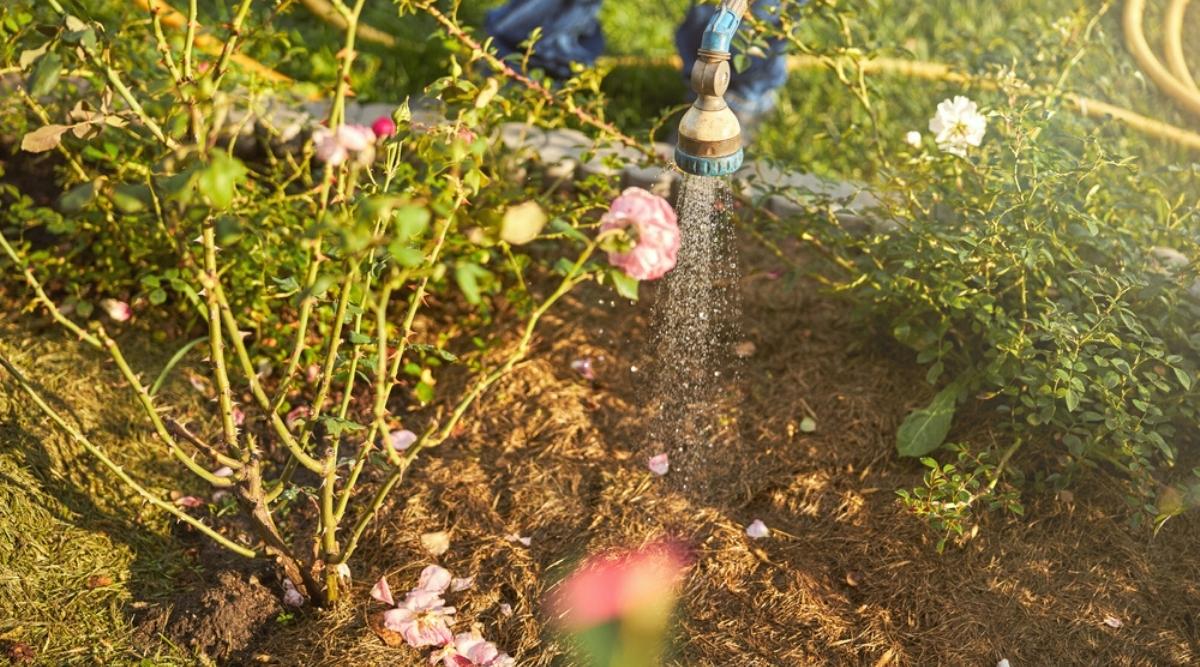 Maintain a good watering regimen for healthy roses to keep them well-hydrated without sitting in soggy soil.
Maintain a good watering regimen for healthy roses to keep them well-hydrated without sitting in soggy soil.
Roses like to be well-hydrated but resent sitting in soggy soil. Overly-wet soil can cause fungi to develop and may lead to fungal root rot. A good watering regimen will go a long way toward keeping them healthy. Remember to water at the root line rather than overhead to reduce the likelihood of fungal issues.
Symptoms: Overwatered roses can develop soft, yellow leaves that eventually drop off. The whole plant may start to droop. In extreme cases, stems will turn mushy.
Underwatering tells your rose it needs to conserve energy. It will reduce or stop bloom production and appear brittle, dry, dull, and wilted.
Solve it:
- Instead of daily shallow watering sessions, water roses deeply and less frequently. Mature roses need around 2-3 gallons of water, once a week, depending on the weather (increase during drought, high heat, and for roses in their first year).
- Assess when water is needed by doing the knuckle test- stick your finger knuckle deep into the soil at the base of your rose. If it’s moist at that level, the rose can wait. If it’s bone dry, water again.
- Mulch around your roses (leaving the base of the canes uncovered) to retain moisture and cool the soil.
Heat Stress
 Hot weather above 85℉ affects roses, causing potential dormancy and dropped flowers.
Hot weather above 85℉ affects roses, causing potential dormancy and dropped flowers.
Just like people, roses are affected by weather extremes. They start to struggle when temperatures exceed 85℉. In intense heat, they may enter a period of dormancy, where they sacrifice blooms to conserve energy.
Symptoms: Heat-stressed roses may display leaf scorch (yellow or brown crispy leaves), drop their leaves, and wilt. Already-stressed plants can also become more susceptible to other diseases, so if you have identified a plant suffering from heat stress, monitor its progress to ensure it doesn’t contract another plant disease as a result.
Solve it:
- During a heat wave, provide protection from intense afternoon rays by moving potted roses to shade and covering those planted in-ground with an umbrella or shade cloth when possible.
- Increase watering, using the knuckle test to determine when roses need more.
- If high heat is normal for your area, plant roses that perform well in hot conditions.
Final Thoughts
Don’t let these common issues deter you from growing roses. These long-lived perennials are actually pretty tough! When you see a problem, observe the symptoms to identify the cause and the right way to handle it.
Remember that good care leads to healthy roses that are less susceptible to problems. Even better are roses bred with a high tolerance for pests and disease. Start with varieties that grow well in your region and zone, work on the basics, and enjoy your roses!



